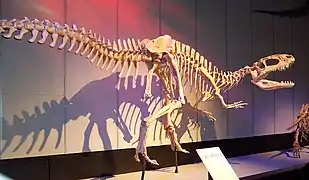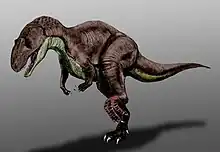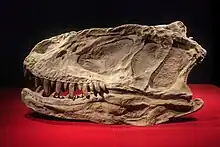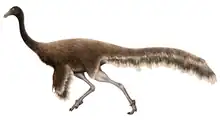Sinraptor
Sinraptor (/sɪnˈræptər/) is a genus of metriacanthosaurid theropod dinosaur from the Late Jurassic. The name Sinraptor comes from the Latin prefix "Sino", meaning Chinese, and "raptor" meaning robber. The specific name dongi honours Dong Zhiming. Despite its name, Sinraptor is not related to dromaeosaurids (often nicknamed "raptors") like Velociraptor. Instead, it was a carnosaur distantly related to Allosaurus.[1] Sinraptor and its close relatives were among the earliest members of the Jurassic carnosaurian radiation. Sinraptor still remains the best-known member of the family Metriacanthosauridae,[2] with some older sources even using the name "Sinraptoridae" for the family.[1]
| Sinraptor | |
|---|---|
 | |
| S. dongi, Royal Tyrrell Museum | |
| Scientific classification | |
| Domain: | Eukaryota |
| Kingdom: | Animalia |
| Phylum: | Chordata |
| Clade: | Dinosauria |
| Clade: | Saurischia |
| Clade: | Theropoda |
| Family: | †Metriacanthosauridae |
| Subfamily: | †Metriacanthosaurinae |
| Genus: | †Sinraptor Currie and Zhao, 1993 |
| Type species | |
| †Sinraptor dongi Currie and Zhao, 1993 | |
| Other species | |
| |
| Synonyms | |
|
Synonyms of S. dongi
Synonyms of S. hepingensis
| |
Discovery


The holotype specimen of Sinraptor was uncovered from the Shishugou Formation during a joint Chinese/Canadian expedition to the northwestern Chinese desert in 1987, and described by Philip J. Currie and Zhao Xijin in 1993.[1] Standing nearly 3 meters (9.8 feet) tall and measuring roughly 7.6 meters (25 feet) in length, two species of Sinraptor have been named. S. dongi, the type species, was described by Currie and Zhao in 1993. A second species, originally named Yangchuanosaurus hepingensis by Gao in 1992,[3] may actually represent a second species of Sinraptor. Whether or not this is the case, Sinraptor and Yangchuanosaurus were close relatives, and are classified together in the family Metriacanthosauridae.[2] Gregory S. Paul proposed that S. dongi would reach 8 metres (26 ft) in length and 1.3 metric tons (1.4 short tons) in body mass,[4] while Holtz estimated it to be 8.8 metres (29 ft) in length.[5]
The dentition of Sinraptor was very similar to that of Allosaurus and indicated that it likely would have preyed upon medium-sized dinosaurs such as stegosaurs by using its blade-like teeth to inflict massive, fatal wounds.[6]
The skeleton of Sinraptor hepingensis (formerly referred to Yangchuanosaurus) is on display at the Zigong Dinosaur Museum in Zigong, China.

Pathology
Sinraptor dongi skull specimen IVPP 10600 exhibits "a variety of gently curving tooth drags or gouges, shallow, circular punctures and one fully penetrating lesion." One rib was broken and healed via telescoping of its capitular shaft.[7]
References
- Currie, Phillip J.; Zhao, Xi-Jin (1993). "A new carnosaur (Dinosauria, Theropoda) from the Jurassic of Xinjiang, People's Republic of China" (PDF). Canadian Journal of Earth Sciences. 30 (10): 2037–2081. doi:10.1139/e93-179.
- Carrano, M. T.; Benson, R. B. J.; Sampson, S. D. (2012). "The phylogeny of Tetanurae (Dinosauria: Theropoda)". Journal of Systematic Palaeontology. 10 (2): 211–300. doi:10.1080/14772019.2011.630927. S2CID 85354215.
- Gao, Yuhui (1992). "Yangchuanosaurus hepingensis – a new species of carnosaur from Zigong, Sichuan" (PDF). Vertebrata PalAsiatica. 30 (4): 313–324.
- Paul, Gregory S. (2016). The Princeton Field Guide to Dinosaurs. Princeton University Press. p. 97. ISBN 978-1-78684-190-2. OCLC 985402380.
- Holtz, Thomas R. Jr. (2012). "Dinosaurs: The Most Complete, Up-to-Date Encyclopedia for Dinosaur Lovers of All Ages" (PDF).
- Hendrickx, Christophe; Stiegler, Josef; Currie, Philip J.; Han, Fenglu; Xu, Xing; Choiniere, Jonah N.; Wu, Xiao-Chun (2020). "Dental anatomy of the apex predator Sinraptor dongi (Theropoda: Allosauroidea) from the Late Jurassic of China". Canadian Journal of Earth Sciences. 57 (9): 1127–1147. doi:10.1139/cjes-2019-0231.
- Molnar, R. E., 2001, Theropod paleopathology: a literature survey: In: Mesozoic Vertebrate Life, edited by Tanke, D. H., and Carpenter, K., Indiana University Press, p. 337-363.

.jpg.webp)












